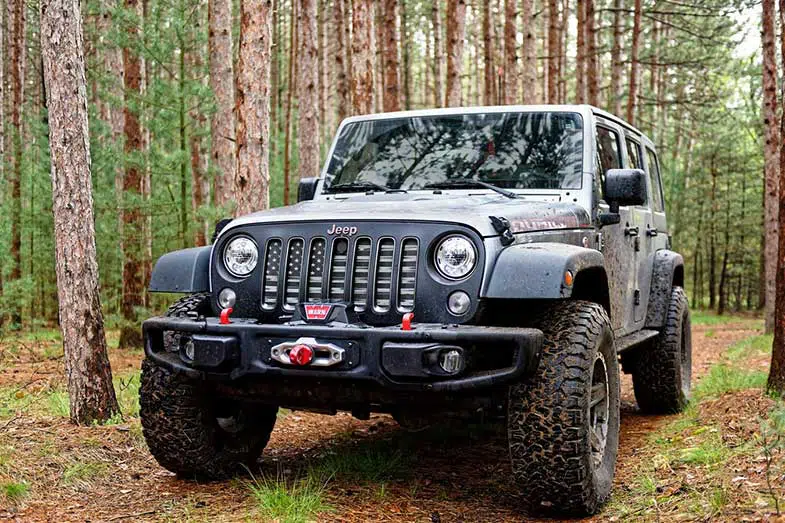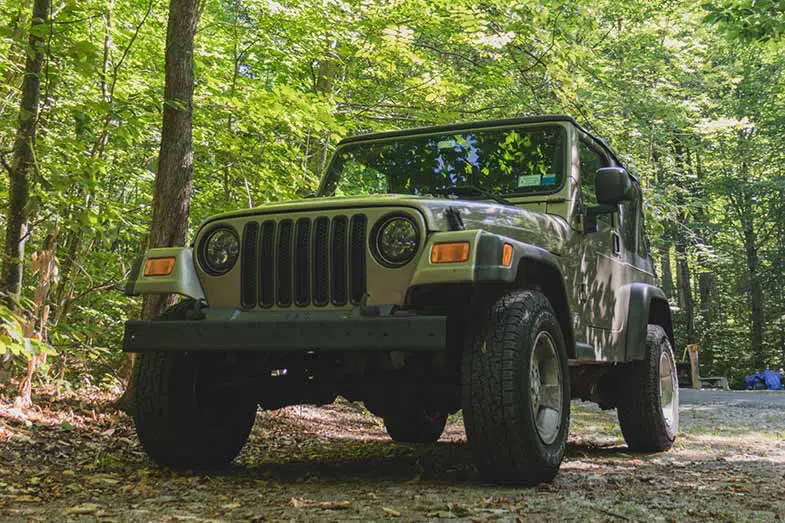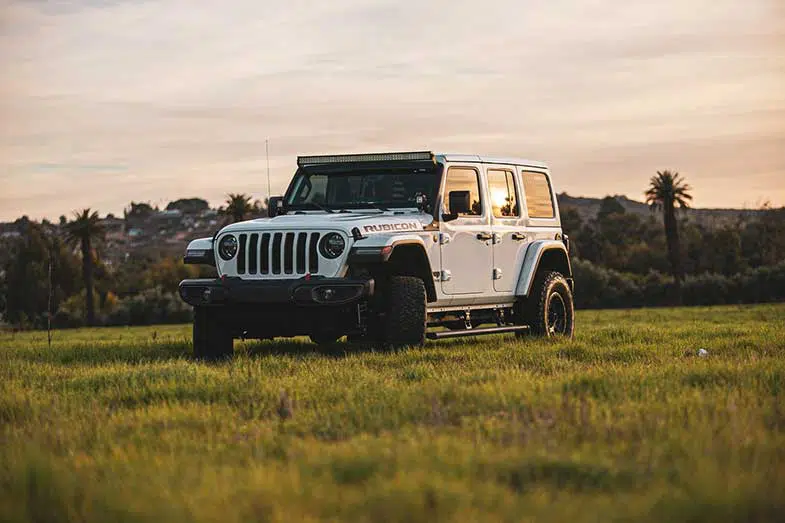It’s easy to get lost amid the flashy bodywork and specs when buying a Jeep. These versatile trucks generally all have Sunrider folding soft tops, a 3.6 or 3.8-liter engine, and options between a manual and automatic transmission. Being off-road specialists and splendid city SUVs at the same time, all Jeep models are hybrids to a degree. This adaptability is perhaps why it can be difficult and confusing to tell them apart. But worry no more. This article will discuss the various trim levels of a Jeep and the difference between Wrangler and Rubicon.
So what is the difference between Rubicon and Wrangler? The Rubicon is one of many Wrangler trim levels that have been in production since 2003. Whereas, the Wrangler is what you call the entire Jeep series of military-looking SUVs.
This article will help give you a clear-cut definition of what a Jeep Rubicon is, tips on selecting your next Wrangler, and a rundown of three key features of three of the most well-known Jeep trims to date.
Jeep Wrangler: An Orientation
For starters, questioning the difference between Rubicon and Wrangler would not be the right thing to ask. The Jeep Wrangler is a series of compact, off-road SUVs that indirectly spun off from WWII Jeeps of the ’40s, and has been in production since 1986. On the other hand, the Rubicon is only one of several trim packages of the Jeep Wrangler, which began production 17 years after. So both should not be compared because it’s like comparing the Wrangler to itself.

What may have caused the confusion between Rubicon and Wrangler is that the Rubicon has become the most popular Jeep edition since its release in 2003. And although the Sahara and Sport versions are equally famous in their own right, the Rubicon Jeep has distinguished itself as Wrangler’s top-of-the-line trim. Unlike other Jeep Wranglers, which later on had to be modified to optimize their off-roading potential, the Jeep Rubicon was ready to hit raw trails and inhospitable roads straight from the dealership. With its superior transfer case, low gear range, and mud-terrain tires, it was an answered prayer for Jeep buyers spared from the agony of upgrading their vehicles.
The Wrangler Maze
Despite the Rubicon’s popularity, people still confuse it with other Wrangler trims for several reasons. Firstly, the Rubicon looks like a Sahara-trimmed Wrangler with additional off-road capabilities. Secondly, most Jeeps end up looking almost similar because of modifications and aftermarket parts sold everywhere. Lastly, all Wrangler models from the 2nd generation until present have the same tapering nose design, fold-down windshields, flared fenders, and trademark circular headlights.

Rubicon vs. Sahara vs. Sport
The difference between Jeep Wrangler Rubicon and Sahara (or any other trim) varies from case to case, as most owners modify their Jeeps in some way. Not to mention that a substantial number of trims have been produced by the manufacturer, which makes the task of telling them apart more complicated than people think. For this reason, I would be limiting the selection to 2020 Jeep Wrangler’s top three trim packages – the Rubicon, the Sahara, and the Sport – so that we can better pinpoint their differences. The table below sums up their key specs and features:
| DIFFERENCES | Jeep Wrangler Rubicon | Jeep Wrangler Sahara | Jeep Wrangler Sport |
| Price (MSRP) | $38,695 (up to 42,440) | $38,645 (up to $40,190) | $28,295 (up to $34,995 for the Sport S) |
| Interior/Exterior | Premium cloth and leather-trimmed, low-back bucket seats Sky One-Touch™ Power Top | Cloth and leather-trimmed, low-back bucket seats Sky One-Touch™ Power Top | Cloth, low-back bucket seats Mesh and solid sunbonnet tops |
| 4WD Systems | Rock-Trac® 4:1 Low Transfer Case | Command-Trac® 4×4 System Full-Time Selec-Trac® 4×4 System (optional) | Command-Trac® 4×4 System |
| Electric/Mechanical | Electronic Front Sway Bar Disconnect Rock rails 7-inch Uconnect® 4 center console Available LED Lighting Group 115-volt auxiliary outlet | Front Stabilizer Bar eTorque Mild Hybrid System 8.4-inch Uconnect® 4C NAV center console | ParkView® Rear Back-Up Camera 5-inch Uconnect® 4 center console (7-inch available for the Sport S) LED Headlamp and Fog Lamp Group (only for Sport S) |
| Suspension | Performance suspension | Heavy-duty suspension with Gas shock | Normal-duty suspension |
| Axle Ratios | 4.10 Front / Rear Axle Ratio Next Generation Dana 44 Heavy Duty Front Axle Next Generation Dana 44 Heavy Duty Rear Axle | 3.21 Front / Rear Axle Ratio Next Generation Dana 30 Solid Front Axle Next Generation Dana 44 Heavy Duty Rear Axle | 3.73 Front / Rear Axle Ratio Next Generation Dana 35 Solid Front Axle Next Generation Dana 44 Heavy Duty Rear Axle |
| Differentials | Tru-Lok® Electronic Locking Differential (Front and Rear Axles) | Conventional Differential Front and Rear Axles | Conventional Differential Front and Rear Axles |
| Towing Capacity | 3,500 lbs | 3,500 lbs | 2,000 lbs (3,500 lbs for the Sport S) |
| Wheels | 17-Inch x 7.5-Inch Machined Wheels with Black Pockets/Machined Lip, paired with 33-Inch All-Terrain Tires and High Clearance Fender Flares | 18-Inch x 7.5-Inch Tech Gray Polished Face (or with Gray Spokes) Wheels | 17-Inch x 7.5-Inch Black Steel Styled Wheels (Tech Silver Aluminum/Granite Crystal Wheels for Sport S; 30-inch wheel and tire group optional) |
| Standout Characteristic | Off-road capabilities | Fancy, timeless aesthetic | Most affordable, mainstream version |
All three trims can be fitted with a Sunrider Soft Top and have a 3.6-Liter V6 24-Valve VVT Engine and 285 horsepower/260 lb-ft of torque. They also have similar fuel economy ratings and offer both two-door and four-door versions (except for the 2020 Jeep Sahara, which is limited to a four-door option this year). What makes each noticeably different is that they individually appeal to a specific market niche. The Sahara would favor picky buyers who are after luxury and style, while the Rubicon Jeep would entice enthusiasts who have a deep love for the outdoors. The Sport would appeal to the average knowing consumer who wants a balance between having an iconic weekend off-roader and a sturdy daily driver.
Which Wrangler Should I Buy?
On top of researching the different trim packages, there are several other factors to consider when deciding to buy a Wrangler. Let us go over each one in detail:
- Budget. Your budget is the first and most important determinant of which Wrangler you will end up purchasing. While everyone can appreciate the improvements done to the vehicle to make it more comfortable and capable off-road, there is no denying that Jeep Wranglers are not inexpensive. Depending on the specific trim you are looking at, this year’s Jeep Wrangler versions are $3,500 to $4,000 more expensive than the outgoing models.
- Vehicle usage. Do you intend to do a lot of rock-crawling and exploits in the wild? The Rubicon outscores its other two siblings in this area. Are your off-road adventures limited to weekly camping with friends? Then the Sahara is the better option. Don’t you have anything planned in the next two or three weeks and only want a sturdy everyday commuter you can flaunt at the beach? The Sport is the perfect choice out of the three.
- Mechanical skill. There are three types of Jeep consumers: the hobbyist mechanic, the new vehicle owner, and the veteran off-roader. If you are the mechanic, you prefer to personalize your vehicle your way and probably go for the Sport, the base Wrangler model. If you are the newbie, you crave to show off your Jeep status but want little to do with unnecessary upgrades and probably opt for the Sahara. But if you’re the veteran who’s unafraid of doing complex engine repairs and frequently ventures off-grid, then the Rubicon is king.
- Driving experience. Consumers have varying degrees of driving experience, similar to their mechanical skills. New Jeep owners are initially unaccustomed to rough rides and typically prefer the Sahara for its comfort and components that promote ease of driving. In contrast, budding mechanics have considerable off-road driving experience under their belt and lean towards picking either a Sport or Rubicon. Then there are the off-roading veterans who ride steep inclines and dirt roads for breakfast and choose the Rubicon in a heartbeat.

Carefully going through these points will guarantee you a Jeep Wrangler purchase that you will never regret. No matter what you go with, any of these Wrangler trims is a great choice! No four-wheeler is more exciting and fun to drive than a Jeep, whether you are on hard-packed sand or the city highway.
Common Questions
- What does Jeep Rubicon mean? The Jeep Wrangler Rubicon got its name from The Rubicon Trail in the Sierra Nevada Mountains – it suits the four-wheeler since it is the best Wrangler trim in terms of off-road capabilities.
- What is the difference between the Jeep Wranglers? The difference between the Jeep Wranglers and different trim packages has more to do with performance, comfort, safety, and convenience than mechanical components and design. All Jeep Wranglers are known for their off-road capabilities, two-door and four-door options, big wheels, and signature nose and headlights.
- Is the Jeep Rubicon worth the extra money? A Jeep Rubicon in stock or near-stock form is definitely worth the money and retains high value at resale, especially if you keep the transfer case, axles, and lockers and only do small mods with the tires and lift kits. But suppose you are planning on doing big lifts and large tires. In that case, you’re better of getting a Sport or a Sahara as you will end up installing Dana 60 Axle Assembly and an advanced adapter transfer case on your Rubicon.
- Why is the Rubicon more expensive? The Rubicon comes with next-generation Dana 44 axles, all-terrain tires, electronic lockers, and other off-road luxuries that other Wrangler trims don’t have or may have as an option. Retaining the factory warranty with all these great features is a bonus, compared to a base model where you immediately lose your warranty once you install upgrades.
- What is the best Jeep model to buy? It depends on the buyer’s budget, followed by their personal preferences. But if you are basing it on budget alone and can afford to splurge on a Wrangler, then the best purchase would either be a Jeep Rubicon or a Jeep Sahara.
About FCA
Fiat Chrysler Automobiles is an Italian-American auto manufacturer and maker of the Jeep Wrangler Rubicon, Sahara, and Sport. It is the 8th biggest automaker in the world and is currently a well-known family brand of sedans, minivans, and full-size car segments in the United States. Fiat Chrysler Automobiles is prepared to merge with Groupe PSA in 2021, changing its company name to Stellantis. FCA’s portfolio includes Abarth, Alfa Romeo, Chrysler, Dodge, Fiat, Fiat Professional, Jeep, Lancia, Maserati, and Ram. The firm continues its successful global operations in over 130 countries worldwide.
Conclusion – What’s the Difference between Rubicon and Wrangler?
Whether you are new to the off-roading community or not, telling the difference between Rubicon and Wrangler can be an exciting challenge. The ability to distinguish them from each other depends on how well you know about Jeep Wranglers. Luckily, there is more clarity to the individual differences of the different Wrangler trims – thanks to Jeep forums, online references, and research.
The three most popular Wrangler trims – the Rubicon, Sahara, and Sport – all have the classic Jeep at the heart of their design. They all offer first-rate, off-roading capabilities, and rugged, boxy style. What sets them apart from others is how they appeal to the consumer’s taste and preferences. Nonetheless, anyone of them is a splendid choice if you are looking for an everyday ride that you can also put through its paces. Be it the Rubicon or a base model that you select; you definitely cannot go wrong with a Jeep Wrangler!
Kris is an avid off-roader and outdoor enthusiast who loves to brave the elements and take on challenging terrain. He also enjoys sharing his passion and knowledge with others so that they, too, can appreciate the ride.
About Kris
